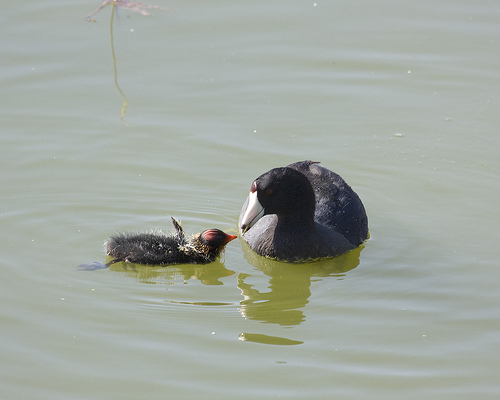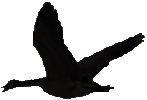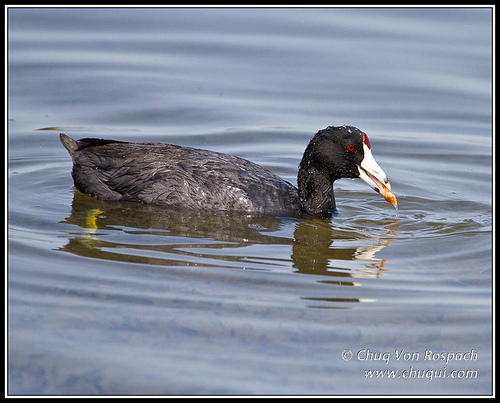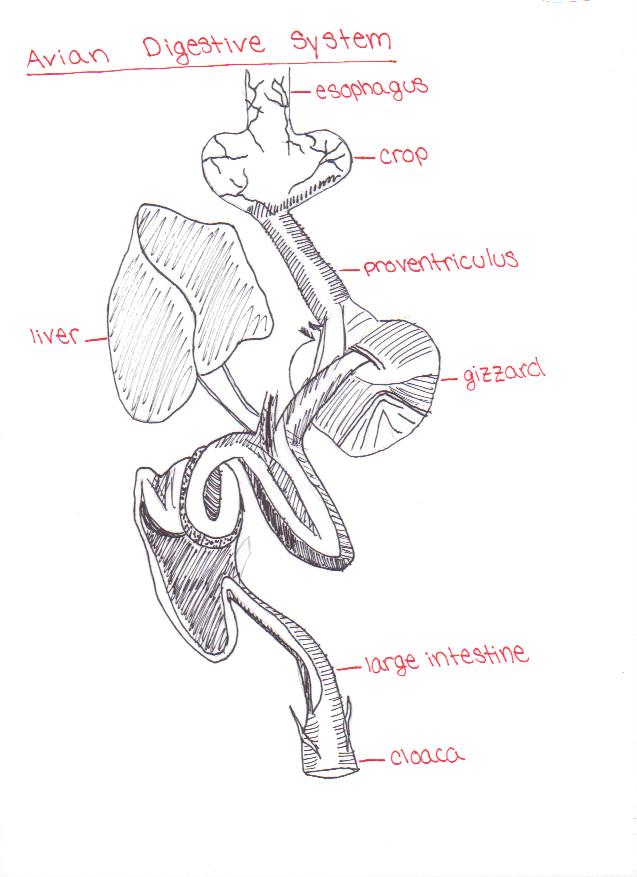Nutrition
Nutrition is a fact of life for all organisms. For the American Coot nutrition acquisition is what it spends most of its time doing. In this section you will learn how the Coot acquires the nutrients necessary for daily activities, what the American Coot likes to eat, some of the organisms it is a host for, information about the circulatory system, and how the Coot transports food through its body .
Because the American Coot has a mixed beak type of a filter beak and a catching insects beak it can be in several places to acquire food. Mostly the American Coot is found diving in the water to get food. The filtering beak allows the Coot to filter out the gulps of water and mud it takes in while also taking up vegetation or small fish or insects. Instead of completely diving into the water the Coots may also act like ducks and simply dip their head in and grab a beak full of water and various other things. When the Coot is on land it bends down and picks up food with its beak. If the Coot gets lazy and does not feel like hunting for its own food it will venture into neighboring nests and steal food. Even though the Coot might be on land they are still near bodies of water.
The American Coot enjoys a variety of food and what they eat depends mostly on where they are at the moment. For a list of what their diet mostly consists of see below.

· Aquatic
vegetation (algae)
· Small fish (minnows)
· Tadpoles
· Crustaceans
· Snails
· Worms
· Aquatic and terrestrial
insects
· Eggs of other birds
· Duckweed
Even though the American Coot does not have a host it is a host for other organisms. One such type of organism that infects the American Coot is a virus that causes Avian Pox. Avian Pox has been reported in at least 60 species of birds and American Coots are at risk. This virus can be spread like any other virus. By coming in contact with other infected individuals, contaminated surfaces, food, or water the virus can start taking over. There are two forms of this virus. The first form is more common and is noticeable by the wart-like growths that appear on the body. These growths can appear where feathers cannot be found such as around the eyes, beak, and feet. The second form is much worse than the first. The mucous membranes of the mouth, throat, trachea, and lungs develop plaques on them and the result is difficulty in breathing and feeding. The birds that are infected with this form usually don't live long because secondary infections often develop leaving the bird too sick to perform daily functions. Avian Pox can usually be observed in the temperate parts of the world and can be timed with mosquito cycles. To get a look at what Avian Pox could potentially look like on waterfowl like the American Coot check out this picture of Avian Pox on a duck: http://www.flickr.com/photos/24020445@N02/3245739675/.
Another organism that uses the American Coot as a host is the virus that causes Avian Influenza, also known as Bird Flu or H5N1. This virus can occur naturally in the intestines of many birds but wild birds usually do not get sick from the virus. Domesticated birds such as chickens, ducks, and turkeys can get very sick from the virus, however, and possibly die. The "low pathogenic" form can possibly go unnoticed in several species of bird and cause mild symptoms which include ruffled feathers and a decrease in egg production. The "high pathogenic" form of Avian Influenza may affect several internal organs and spread rapidly through flocks, especially if in close contact with each other. The mortality rate of Avian Influenza for the "high pathogenic" form can reach 90%-100% within 48 hours of one bird becoming infected.
The circulatory system for the American Coot is the same for all avian species. It consists of two circuits and four chambers (right atrium, left atrium, right ventricle, and left ventricle). This system is closely related to mammals because they also have two circuits and four chambers. Reptiles like crocodiles have two chambers and four circuits like the birds and mammals but other reptiles such as lizards and snakes have two circuit and three chambers (right atrium, left atrium, and the ventricle) in their circulatory system.
The digestive system of birds is different from other digestive systems in the phylum chordata. Birds who can eat at a faster rate than the rate at which they digest have an organ called a crop. In order to feed their young, parents can regurgitate their food that was stored in the crop. In the case of the Coot they can regurgitate to make plant material easier to take up for the chicks. The crop is an enlarged pouch part of the esophagus which can be found in the neck region. The next part of the digestive system is an organ similar to the stomach of a mammal called the proventriculus. Here acidic components break down food material, specifically the proteins. After that the food moves into the gizzard where food is broken down even more. The gizzard is a strong muscular sac where pebbles or shell grit can be found in most birds to help with the break down process. As in mammals birds have a relatively long intestinal tract. Here nutrients are absorbed as the material moves along and is finally passed out the cloaca. This is a single opening at the end of the digestive tract used in digestive, reproductive, and urinary systems.
Click here to learn how American Coots have adapted to obtain nutrition.
Click here to learn about the reproduction and life history of the American Coot.



